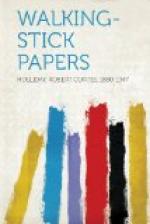When the present enthusiast for the splendid subject of hats was a small boy it was the ambition of every small boy of his acquaintance to be regarded as of sufficient age to possess what we termed a “dice hat,” what is commonly called a “derby,” what in England they call a “darby,” what Dickens aptly referred to as a “pot-hat,” what, in one highly diverting form, is sometimes referred to on the other side as a “billycock.” That singular structure for the human head, the derby hat, one time well-nigh universally worn, has now gone somewhat out of fashion and been superseded by the soft hat of smart design, though there are indications, I fear, that the derby is coming in again. When we were young the soft hat was most commonly worn by veterans of the Civil War, in a pattern called a “slouch hat” or “Grand Army hat.” Though, indeed, such romantic beings as cowboys in popular ten cent literature and the late Buffalo Bill wore sombreros, and the picturesque Mexican a high peaked affair.
Our grandfathers wore “stove-pipe hats”; and the hats of politicians were one time frequently called “plug hats.” This male head-dress even more extraordinary than the derby, books of etiquette sometimes say you should not call a “silk hat” but a “high hat.” In London but a few years ago no man ever went into the City with other than a top-hat, or “topper” as they say there. It is said that the going out of general favour of the silk hat has been occasioned in a considerable degree by the popularity of raincoats in preference to umbrellas. If you observe any great crowd in England to-day you will find in it few hats of any kind; it is in the main a sea of caps. The American “dude” and the anti-bellum British “knut” always wore silk hats. Gentlemen at the British race courses and fine old clubmen of Pall Mall affect a white or grey top hat, of the sort which was so becoming an ornament to the late King Edward. The opera hat is said to have startled many persons who had not seen it before. Intoxicated gentlemen in funny pictures have always smashed their silk hats. Some men have worn a silk hat only on the occasion of their marriage. High hats are worn by small boys in England. The most useful occupation to-day is that which envolves the wearing of a “tin hat.”
The day in the autumn fixed by popular mandate when the straw hat is to be discarded for the season is hilariously celebrated in Wall Street by the destruction by the affronted populace of the straw hats of those who have had the temerity or the thoughtlessness to wear them. Coloured men in livery stables, however, sometimes wear straw hats the year round. To the habit generally of wearing a hat baldness is attributed by some. And the luxuriant hair of Indians and of the cave-man is pointed to as illustrating the beneficent result of not wearing a hat. And now and then somebody turns up with the idea in his head that he doesn’t need a hat on it. There is a white garbed gentleman of Grecian mould who parades Broadway every day without a hat.




